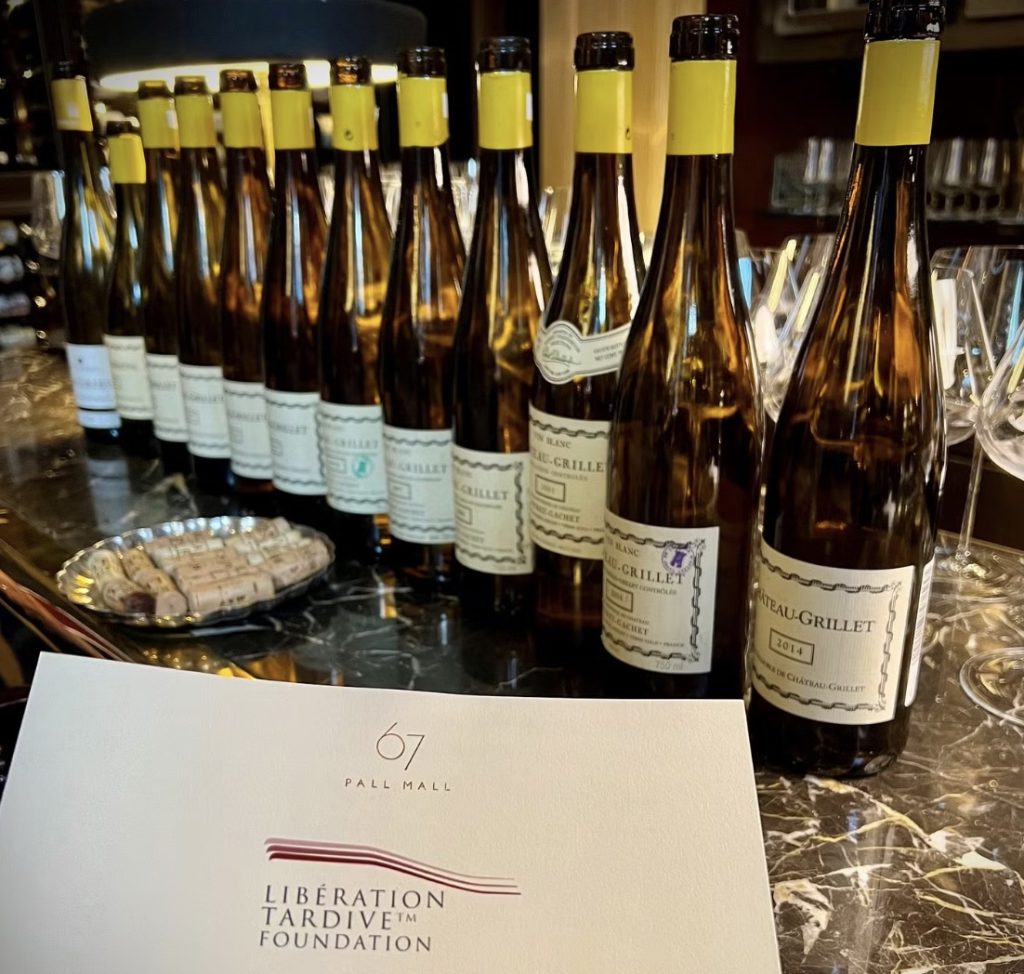Dominic Buckwell raids his own cellar and pours his collection of Château-Grillet wines to a prestigious and appreciative panel, to mark the launch of Liberation Tardive, a new not-for-profit organization that seeks to ensure the market delivers available stocks of older wines.
How does it feel to taste something from history? A tiny appellation in Northern Rhône, with Roman origins acclaimed by Thomas Jefferson – a grape variety saved from the edge of extinction – a family estate revived from doldrums by France’s second wealthiest person.
I had never heard of Château-Grillet until 2015, when Michael Schuster mentioned it in passing on his fine wine course. The name sounded like a minor Bordeaux estate, was this an also-ran claret? Definitely not: an unusual white grape (Viognier) with its own monopole appellation, adjacent to Condrieu in Northern Rhône, where over 95% of the wine is red, I was intrigued.
When 67 Pall Mall initially opened, they had some 2010 Grillet listed by the glass. I was able to taste it in about 2016. I felt it wasn’t worth the money (what iconic wines ever are?) but still wanted to better understand it. Reading Jancis Robinson’s Purple Pages, she wrote: ‘For years it seemed blithely unaffected by rising standards everywhere else but has now been taken in hand by the team that runs Château Latour.’
In 2019, I had the opportunity (I mean excuse) when updating the Rhône segment in Tom Stevenson’s The New Sotheby’s Wine Encyclopedia to evaluate the then recent vintages of Grillet (2013-15), since its sale by the Neyret-Gachet family to Francois Pinault’s Artemis Group. The key question for me was since the reinvestment by this mega brand conglomerate, does the wine now live up to justify the notoriety and price?
The 2019 conclusions suggested that re-investment in the estate had led to improvements: lowering yields; retraining and replanting vines; building a new winery; and reducing the use of new oak have allowed the complexity of the wine to predominate. Selecting the fruit, vinifying separate parcels and declassifying some also enables production of a less expensive second wine: Côtes-du-Rhône Blanc. Evaluating Grillet against leading Condrieus of the same vintages, Grillet appeared to be moving up the ranks since the 2011 sale: 2015 improved on 2014, and 2014 on 2013.
More recently, I have become involved with a new not-for-profit organization founded on the axiom that ‘Great Wines Take Time’. The purpose of Liberation Tardive (LT) is to ensure the market delivers available stocks of older wines, so the market can enjoy the fruits of winemaking techniques designed to produce wines capable of improving with bottle age. Everyone in the supply chain stands to benefit: growers, producers, exporters, importers, wholesalers, storage companies and retailers – from an improved understanding and appreciation of aged wines. With the rush for cash flow, ROI (Return on Investment) and speculators locking up stocks of wines intended for consumption, the enjoyment and appreciation of such rarefied bottles is arguably ‘at risk’.
For LT to function it will need supporters. To kick start the initiative, I raided my cellar for a small tasting to look at the 2014-2018 vintages of Château-Grillet, as well as a handful of older vintages to see how this wine ages. The tasting also included a wine from Stephane Ogier and a Côtes-du-Rhône from Château-Grillet. Four flights were arranged as follows:
Flight 1
Stephane Ogier, Les Vielle Vignes de Jacques Vernay, Condrieu 2018
Château Grillet 2018
Château Grillet Côtes-du-Rhône 2018
Flight 2
Château Grillet 2015, 2016, 2017
Flight 3 – older vintages
Château Grillet 2006, 2007, 2009
Flight 4 – Three other vintages tasted semi-blind (ie the wine was disclosed but not the vintages)
Château Grillet 2014, 2004, 2001
With only one bottle of each, I could not invite more than a handful of guests. In order to glean publicity and informed comments the following team of experts joined me in the Lutyens room at 67 Pall Mall to taste these wines: Jancis Robinson MW OBE, John Livingstone-Learmonth, Richard Bampfield MW, Anne McHale MW, Andy Howard MW, Christopher Burr MW, Pauline Vicard, John Stimpfig, and Matt Walls.

After the first flight, John Livingstone-Learmonth chimed in that the 2018 Grillet did not show well, and made him question if it deserved the status. However, the Ogier was benchmark and well balanced, delivering exactly what a Viognier should for one-fifth of the price. The Côtes-du Rhône 2018 also showed relatively well, and several others including Anne and Pauline felt it worth the money, unlike the 2018 Grand Vin.
The second flight was incredibly varied, the 2017 being too young and tight, but showing potential, and the 2015 rather too oxidative for some. But for Richard, Pauline and myself it was the more complex, ready and enjoyable for this.
The third flight was the most discussed, with 2006 not hitting the mark, but 2009 delighted even John, the doubter. The other John (Stimpfig) was particularly enamoured by the 2009, declaring that this wine alone proved the point of Liberation Tardive. It was wine of the night and effectively launched the LT ship. Let see where she sails next….
Liberation Tardive would be interested to hear from members or Friends of the Circle who would be interested in getting involved with the organisation. Especially as the association has a vacancy for a director, ideally looking for someone with executive leadership skills, as well as publicity, communication and fundraising experience in the international fine wine industry. While the immediate focus of events will be in London the ideal candidate need not be UK based.
Email [email protected] or call Dominic on +44 7973 406415 for further information.

